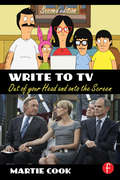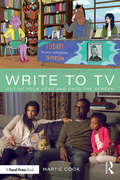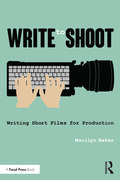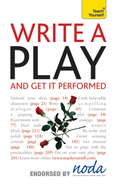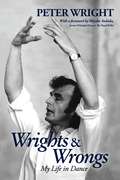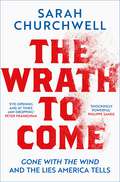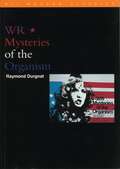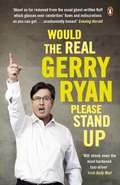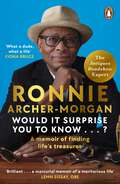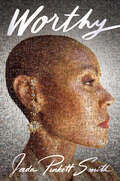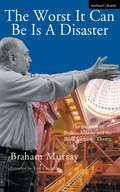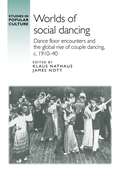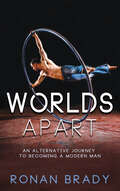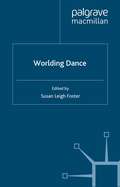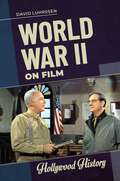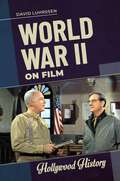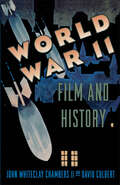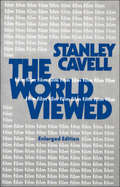- Table View
- List View
Write to TV: Out of Your Head and onto the Screen
by Martie CookLearn to craft smart, original stories and scripts for a variety of television formats and genres, including comedy, drama, pilots, animation, made-for-TV movies, late night, and reality television. Hear directly from studio and network executives, agents, and managers on what they’re looking for in new writers and how to avoid common pitfalls. Gain access to sample outlines, script pages, checklists, and countless other invaluable resources that will help you break into the industry and put you on the path to immediate success. In Write to TV, Second Edition industry veteran Martie Cook offers practical advice on writing innovative television scripts that will allow you to finally get that big idea out of your head and onto the screen. This new edition has been updated to include: Tips and techniques from industry vets Jay Leno, Norman Lear, Paul Haggis, David Magee, Susan Rovner, Tal Rabinowitz, Jonathan Littman, Peter Jankowski, Steve Stark, and Doug Herzog that you can immediately apply to your own projects Expanded coverage of writing pilots, pitching, writing webisodes, writing for tweens, writing for late night, and rewriting Useful advice for navigating the confusing television hierarchy, including how to network, get an agent, land that first writing job, and even "do lunch" 25 new interviews with writers and producers of hit shows such as New Girl, Parks and Recreation, The Blacklist, Curb Your Enthusiasm, CSI, The Tonight Show Starring Jimmy Fallon, and many more An all new companion website (www.writetotv.com) featuring blog updates, industry trends, a Q&A discussion forum with the author, and many other resources
Write to TV: Out of Your Head and onto the Screen
by Martie CookLearn to craft smart, original stories and scripts for a variety of television formats and genres, including comedy, drama, pilots, animation, made-for-TV movies, late night, and reality television. Hear directly from studio and network executives, agents, and managers on what they’re looking for in new writers and how to avoid common pitfalls. Gain access to sample outlines, script pages, checklists, and countless other invaluable resources that will help you break into the industry and put you on the path to immediate success. In Write to TV, Second Edition industry veteran Martie Cook offers practical advice on writing innovative television scripts that will allow you to finally get that big idea out of your head and onto the screen. This new edition has been updated to include: Tips and techniques from industry vets Jay Leno, Norman Lear, Paul Haggis, David Magee, Susan Rovner, Tal Rabinowitz, Jonathan Littman, Peter Jankowski, Steve Stark, and Doug Herzog that you can immediately apply to your own projects Expanded coverage of writing pilots, pitching, writing webisodes, writing for tweens, writing for late night, and rewriting Useful advice for navigating the confusing television hierarchy, including how to network, get an agent, land that first writing job, and even "do lunch" 25 new interviews with writers and producers of hit shows such as New Girl, Parks and Recreation, The Blacklist, Curb Your Enthusiasm, CSI, The Tonight Show Starring Jimmy Fallon, and many more An all new companion website (www.writetotv.com) featuring blog updates, industry trends, a Q&A discussion forum with the author, and many other resources
Write to TV: Out of Your Head and onto the Screen
by Martie CookIn Write to TV (third edition) industry veteran Martie Cook offers practical advice on writing innovative television scripts that will allow you to finally get that big idea out of your head and onto the screen. With this book you’ll learn to craft smart, original stories and scripts for a variety of television formats and genres, including comedy, drama, pilots, web series, and subscription video on demand. This new edition has been updated with expanded coverage on writing for global audiences, content creation for streaming services such as Netflix, Amazon and Hulu, as well as writing the web series, podcasts and utilizing free platforms such as YouTube. It also features new chapters on writing for niche markets; breaking into the writers’ room; creating binge-worthy series and how to accompany pilot scripts with a series pitch document. Plus, expanded information on creating complex and compelling characters including writing anti-heroes and strong female protagonists and much, much more. Including information directly from studio and network executives, agents, and managers on what they’re looking for in new writers and how to avoid common pitfalls, advice from successful creators and showrunners on creating original content that sells, and tips from new writers on how to get into a writers room and stay there. This book contains information from more than 20 new interviews, access to sample outlines, script pages, checklists, and countless other invaluable resources, and is the ideal book for anyone who wants to break into the TV writing industry.
Write to TV: Out of Your Head and onto the Screen
by Martie CookIn Write to TV (third edition) industry veteran Martie Cook offers practical advice on writing innovative television scripts that will allow you to finally get that big idea out of your head and onto the screen. With this book you’ll learn to craft smart, original stories and scripts for a variety of television formats and genres, including comedy, drama, pilots, web series, and subscription video on demand. This new edition has been updated with expanded coverage on writing for global audiences, content creation for streaming services such as Netflix, Amazon and Hulu, as well as writing the web series, podcasts and utilizing free platforms such as YouTube. It also features new chapters on writing for niche markets; breaking into the writers’ room; creating binge-worthy series and how to accompany pilot scripts with a series pitch document. Plus, expanded information on creating complex and compelling characters including writing anti-heroes and strong female protagonists and much, much more. Including information directly from studio and network executives, agents, and managers on what they’re looking for in new writers and how to avoid common pitfalls, advice from successful creators and showrunners on creating original content that sells, and tips from new writers on how to get into a writers room and stay there. This book contains information from more than 20 new interviews, access to sample outlines, script pages, checklists, and countless other invaluable resources, and is the ideal book for anyone who wants to break into the TV writing industry.
Write to Shoot: Writing Short Films for Production
by Marilyn BekerWrite to Shoot teaches budding screenwriters and screenwriting filmmakers how to write a short script with production in mind. Beker instructs them how to showcase their strengths, tailor projects to shoestring budgets, resources, and practical production parameters without sacrificing the quality and punch of their screenplays, whether they're creating a sizzle short for an unproduced feature script, an independent creative work, or a soapbox to promote a cause. Write to Shoot: Writing Short Films for Production is a must-have guide for anyone who wants to be sure there will be no surprises on set that come from a script that's not ready for production.
Write to Shoot: Writing Short Films for Production
by Marilyn BekerWrite to Shoot teaches budding screenwriters and screenwriting filmmakers how to write a short script with production in mind. Beker instructs them how to showcase their strengths, tailor projects to shoestring budgets, resources, and practical production parameters without sacrificing the quality and punch of their screenplays, whether they're creating a sizzle short for an unproduced feature script, an independent creative work, or a soapbox to promote a cause. Write to Shoot: Writing Short Films for Production is a must-have guide for anyone who wants to be sure there will be no surprises on set that come from a script that's not ready for production.
Write A Play And Get It Performed: Teach Yourself (Teach Yourself)
by Lesley Bown Ann GawthorpeWrite a Play - and Get It Performed is designed for would-be writers of every level and for all types of motivation by two prize-winning professionals. Whether writing for the specific needs of an amateur drama group, community event, political campaign or simply for personal or professional development, this is a guide to the craft of playwriting. It offers guidance on the creative principles of scripts, characters, plot, structure and dialogue and explains the principles of staging and stage directions as well as gives tips on how to write for a variety of different situations, for every age and ability and according to specific genres - particularly those often preferred by amateur groups, such as pantomime and musical theatre.NOT GOT MUCH TIME?One, five and ten-minute introductions to key principles to get you started.AUTHOR INSIGHTSLots of instant help with common problems and quick tips for success, based on the author's many years of experience.TEST YOURSELFTests in the book and online to keep track of your progress.EXTEND YOUR KNOWLEDGEExtra online articles at www.teachyourself.com to give you a richer understanding of writing a play.FIVE THINGS TO REMEMBERQuick refreshers to help you remember the key facts.TRY THISInnovative exercises illustrate what you've learnt and how to use it.
Wrights & Wrongs: My Life In Dance
by Peter Wright Paul ArrowsmithPeter Wright has been a dancer, choreographer, teacher, producer and director in the theatre as well as in television for over 70 years. His many productions of classic ballets are danced by companies not only in Britain but North and South America, Australia and Japan as well as in Europe. His production of Giselle has been danced by National Ballet of Canada for over 40 years. Birmingham Royal Ballet, the company he created, has performed his Swan Lake for 35 years, The Sleeping Beauty for over 30, a production Peter staged in Budapest in April 2016. His different stagings of The Nutcracker at Covent Garden and in Birmingham have charmed audiences for over 30 years. Peter started his career in wartime, with the Kurt Jooss company. He has worked with such greats as Pina Bausch, Margot Fonteyn, Rudolf Nureyev, Marcia Haydée, Richard Cragun, Monica Mason, Karen Kain, Miyako Yoshida and Carlos Acosta – as well as today’s generation of stars including Alina Cojocaru, Marianela Nuñez, Natalia Osipova and Lauren Cuthbertson. While now regarded as part of the British ballet establishment, for many years Peter developed his career outside London, particularly in Germany with John Cranko’s Stuttgart Ballet. That distance gives him a unique and unrivalled view on ballet companies. His close association with choreographers Frederick Ashton, Ninette de Valois, founder of the Royal Ballet, Kenneth MacMillan and David Bintley gives Peter an authoritative perspective on British ballet. In Wrights & Wrongs, Peter offers his often surprising views of today’s dance world, lessons learned – and yet to learn – from a lifetime’s experience of ballet, commercial theatre and television.
The Wrath to Come: Gone with the Wind and the Lies America Tells
by Sarah ChurchwellThe history America never wanted you to read. 'The narrative took my breath away' Philippe Sands 'An extraordinarily and shockingly powerful read' Peter Frankopan 'One of the must-reads of the year' Suzannah Lipscomb 'Brilliant and provocative' Gavin EslerSarah Churchwell examines one of the most enduringly popular stories of all time, Gone with the Wind, to help explain the divisions ripping the United States apart today. Separating fact from fiction, she shows how histories of mythmaking have informed America's racial and gender politics, the controversies over Confederate statues, the resurgence of white nationalism, the Black Lives Matter movement, the enduring power of the American Dream, and the violence of Trumpism.Gone with the Wind was an instant bestseller when it was published in 1936; its film version became the most successful Hollywood film of all time. Today the story's racism is again a subject of controversy, but it was just as controversial in the 1930s, foreshadowing today's debates over race and American fascism. In The Wrath to Come, Sarah Churchwell charts an extraordinary journey through 160 years of American denialism. From the Lost Cause to the romances behind the Ku Klux Klan, from the invention of the 'ideal' slave plantation to the erasure of interwar fascism, Churchwell shows what happens when we do violence to history, as collective denial turns fictions into lies, and lies into a vicious reality.
WR: Mysteries of the Organism (BFI Film Classics)
by Raymond DurgnatIn Dusan Makavejev's controversial and explicit WR - Mysteries of the Organism (1971), 'WR' is Wilhelm Reich, the Marxist psychoanalyst who preached sexual enlightenment as a gateway to a better society. Reich is a 'intellectual maverick' and 'sexual pioneer', and theorist of 'Orgone energy' and 'world revolution'. Loosely inspired by Reich's 'The Function of the Orgasm' WR stages an encounter between psychotherapy and Marxism, sexual permissiveness and socialism. Juxtaposing hippie America and cold war Yugoslavia, it is a film of ideas and sensations which speaks to the contemporary world. It was banned in Yugoslavia, under pressure from Moscow, as politically offensive. This book explores the film and how its spectators interact with it.
WR: Mysteries of the Organism (BFI Film Classics)
by Raymond DurgnatIn Dusan Makavejev's controversial and explicit WR - Mysteries of the Organism (1971), 'WR' is Wilhelm Reich, the Marxist psychoanalyst who preached sexual enlightenment as a gateway to a better society. Reich is a 'intellectual maverick' and 'sexual pioneer', and theorist of 'Orgone energy' and 'world revolution'. Loosely inspired by Reich's 'The Function of the Orgasm' WR stages an encounter between psychotherapy and Marxism, sexual permissiveness and socialism. Juxtaposing hippie America and cold war Yugoslavia, it is a film of ideas and sensations which speaks to the contemporary world. It was banned in Yugoslavia, under pressure from Moscow, as politically offensive. This book explores the film and how its spectators interact with it.
Would The Real Gerry Ryan Please Stand Up
by Gerry RyanGerry Ryan on life, the world, the universe - and a few things besides. Here are his experiences, stories and opinions drawn from nearly thirty years of talking to the nation. It's a sharp, punchy read all told in his no-nonsense, irreverent, straight to the bone style. It's the best, the worst, the funniest, the most outrageous. And threaded through it's the story of coming of age as a broadcaster at the same time as Ireland became a truly modern country. A smart, sassy and wildly entertaining read.
Would It Surprise You To Know…?
by Janet Gleeson Ronnie Archer-Morgan'A fascinating, rollercoaster read, very well told.' - Times'Ronnie has overcome a heart-breaking start in life to achieve great success and no one deserves it more. What a dude, what a life!' - Fiona BruceFor decades, Ronnie Archer-Morgan has brought to life the fascinating, often surprising backstories behind our most cherished heirlooms and household objects on the Antiques Roadshow. Now, he tells his own unlikely story. Born in the fifties to a Sierra Leonean mother battling mental health problems, Ronnie spent his childhood in and out of care. After difficult beginnings, marked by abuse, racism and brushes with both criminals and the police, he got into music, managing to get DJ gigs and, later, worked as a celebrity hairdresser for Vidal Sassoon and Smile in the height of seventies London. A flair for spotting antiques led him to start his own Knightsbridge gallery, ultimately becoming one of the most respected figures in the industry, culminating in a regular spot as an expert on the nation's Sunday favourite, Antiques Roadshow. Told with rich warmth, this is an extraordinary journey from deprivation and abuse to adventure and success against the odds - with stories of the incredible objects which shaped the way.'A surprising story, like many of the objects he appraises on the Antiques Roadshow' - Kate Adie, broadcaster and bestselling author
Worthy
by Jada Pinkett SmithA gripping, painfully honest, and ultimately inspirational memoir from global superstar and creator of the Red Table Talk series Jada Pinkett Smith.
The Worst It Can Be Is A Disaster: The Life Story of Braham Murray and the Royal Exchange Theatre (Biography and Autobiography)
by Braham MurrayThe Worst It Can Be is a Disaster is the autobiography of Braham Murray, founding director of the Royal Exchange Manchester which in 2006 celebrated its thirtieth anniversary. With a foreword by Sir Tom Courtenay.Born into a Jewish family, Braham Murray struggled against his parents' expectations that he should follow them into the world of commerce; instead he became at twenty-two the youngest artistic director in the country when he took over Century Theatre, a theatre company based in Manchester. Detailing his relationships and the theatrical successes and flops along the way, the narrative takes us through his early years with Century Theatre, with the 69 Theatre Company, and the birth of the Royal Exchange Manchester in the heart of Manchester in 1976. Twenty years later, the theatre rose from the ashes of the IRA bomb brilliantly opening a new production on time just ten days after the bomb had destroyed the city centre. The role and influence of the author's Jewish heritage and of his key collaborators - including Caspar Wrede and Michael Elliott - are explored in this illuminating and inspiring account of one of English theatre's great directors.'Braham's passion is sometimes overwhelming, sometimes annoying but completely inspirational. It's his passion that the Royal Exchange has thrived on, and this book is full of his passion for the theatre.' Robert Lindsay
The Worst It Can Be Is A Disaster: The Life Story of Braham Murray and the Royal Exchange Theatre (Biography and Autobiography)
by Braham MurrayThe Worst It Can Be is a Disaster is the autobiography of Braham Murray, founding director of the Royal Exchange Manchester which in 2006 celebrated its thirtieth anniversary. With a foreword by Sir Tom Courtenay.Born into a Jewish family, Braham Murray struggled against his parents' expectations that he should follow them into the world of commerce; instead he became at twenty-two the youngest artistic director in the country when he took over Century Theatre, a theatre company based in Manchester. Detailing his relationships and the theatrical successes and flops along the way, the narrative takes us through his early years with Century Theatre, with the 69 Theatre Company, and the birth of the Royal Exchange Manchester in the heart of Manchester in 1976. Twenty years later, the theatre rose from the ashes of the IRA bomb brilliantly opening a new production on time just ten days after the bomb had destroyed the city centre. The role and influence of the author's Jewish heritage and of his key collaborators - including Caspar Wrede and Michael Elliott - are explored in this illuminating and inspiring account of one of English theatre's great directors.'Braham's passion is sometimes overwhelming, sometimes annoying but completely inspirational. It's his passion that the Royal Exchange has thrived on, and this book is full of his passion for the theatre.' Robert Lindsay
Worlds of social dancing: Dance floor encounters and the global rise of couple dancing, c. 1910–40 (Studies in Popular Culture)
by Jeffrey RichardsBy the 1920s, much of the world was ‘dance mad,’ as dancers from Buenos Aires to Tokyo, from Manchester to Johannesburg and from Chelyabinsk to Auckland, engaged in the Charleston, the foxtrot and a whole host of other fashionable dances. Worlds of social dancing examines how these dance cultures spread around the globe at this time and how they were altered to suit local tastes. As it looks at dance as a ‘social world’, the book explores the social and personal relationships established in encounters on dance floors on all continents. It also acknowledges the impact of radio and (sound) film as well as the contribution of dance teachers, musicians and other entertainment professionals to the making of the new dance culture.
Worlds of social dancing: Dance floor encounters and the global rise of couple dancing, c. 1910–40 (Studies in Popular Culture)
by Jeffrey RichardsBy the 1920s, much of the world was ‘dance mad,’ as dancers from Buenos Aires to Tokyo, from Manchester to Johannesburg and from Chelyabinsk to Auckland, engaged in the Charleston, the foxtrot and a whole host of other fashionable dances. Worlds of social dancing examines how these dance cultures spread around the globe at this time and how they were altered to suit local tastes. As it looks at dance as a ‘social world’, the book explores the social and personal relationships established in encounters on dance floors on all continents. It also acknowledges the impact of radio and (sound) film as well as the contribution of dance teachers, musicians and other entertainment professionals to the making of the new dance culture.
Worlds Apart: An Alternative Journey to becoming a Modern Man
by Ronan Brady‘Ronan is emblematic of how Ireland has changed.’ – Panti BlissAt just under six foot in his socks and weighing in at fourteen stone, Ronan Brady is a solid slab of rarest Roscommon meat. He has a natural tendency to throw himself about – some would say recklessly, others would say enthusiastically – into whatever he sets himself to. Ronan had a ‘normal’ childhood in Roscommon and knew by the time he was a teenager that when he grew up he wanted to play football for his county and become a teacher. Ronan had achieved his life ambition when he took up ‘Flying’ as a hobby. A hobby that transformed his life and took him to heights he never dreamed of, performing in the smash hit show Riot alongside Panti Bliss, and going on to tour the world. Worlds Apart is an open, humorous account of Ronan’s life journey.
Worlding Dance (Studies in International Performance)
by S. FosterWhat world has been constructed for dancing through the use of the term 'world dance'? What kinds of worlds do we as scholars create for a given dance when we undertake to describe and analyze it? This book endeavours to make new epistemological space for the analysis of the world's dance by offering a variety of new analytic approaches.
World War II on Film (Hollywood History)
by David LuhrssenWorld War II on Film examines the war through the lens of 12 films. The movies selected include productions made during World War II and in each succeeding decade, providing a sense of how different generations perceive the war.World War II on Film provides a succinct yet well-grounded appraisal of that war as seen through 12 representative films. The book separates fact from fiction, showing where the movies were accurate and where they departed from reality, and places them in the larger context of historical and social events. Each movie chosen represents a particular aspect of the conflict, including the air war over Europe, the condition of prisoners of war, Nazi atrocities, and the British evacuation at Dunkirk. Unlike most histories of Hollywood during World War II or the genre of war movies, World War II on Film examines in depth the relation between the depictions of events, beliefs, attitudes, and ways of life as seen on film with reality as documented by historians or recorded by journalists or eye-witnesses to the war. The volume will appeal to high school and college readers, as well as general interest readers and film buffs.
World War II on Film (Hollywood History)
by David LuhrssenWorld War II on Film examines the war through the lens of 12 films. The movies selected include productions made during World War II and in each succeeding decade, providing a sense of how different generations perceive the war.World War II on Film provides a succinct yet well-grounded appraisal of that war as seen through 12 representative films. The book separates fact from fiction, showing where the movies were accurate and where they departed from reality, and places them in the larger context of historical and social events. Each movie chosen represents a particular aspect of the conflict, including the air war over Europe, the condition of prisoners of war, Nazi atrocities, and the British evacuation at Dunkirk. Unlike most histories of Hollywood during World War II or the genre of war movies, World War II on Film examines in depth the relation between the depictions of events, beliefs, attitudes, and ways of life as seen on film with reality as documented by historians or recorded by journalists or eye-witnesses to the war. The volume will appeal to high school and college readers, as well as general interest readers and film buffs.
World War II, Film, and History
by John Whiteclay Chambers David CulbertThe immediacy and perceived truth of the visual image, as well as film and television's ability to propel viewers back into the past, place the genre of the historical film in a special category. War films--including antiwar films--have established the prevailing public image of war in the twentieth century. For American audiences, the dominant image of trench warfare in World War I has been provided by feature films such as All Quiet on the Western Front and Paths of Glory. The image of combat in the Second World War has been shaped by films like Sands of Iwo Jima and The Longest Day. And despite claims for the alleged impact of widespread television coverage of the Vietnam War, it is actually films such as Apocalypse Now and Platoon which have provided the most powerful images of what is seen as the "reality" of that much disputed conflict. But to what degree does history written "with lightning," as Woodrow Wilson allegedly said, represent the reality of the past? To what extent is visual history an oversimplification, or even a distortion of the past? Exploring the relationship between moving images and the society and culture in which they were produced and received, World War II, Film, and History addresses the power these images have had in determining our perception and memories of war. Examining how the public memory of war in the twentieth century has often been created more by a manufactured past than a remembered one, a leading group of historians discusses films dating from the early 1930s through the early 1990s, created by filmmakers the world over, from the United States and Germany to Japan and the former Soviet Union. For example, Freda Freiberg explains how the inter-racial melodramatic Japanese feature film China Nights, in which a manly and protective Japanese naval officer falls in love with a beautiful young Chinese street waif and molds her into a cultured, submissive wife, proved enormously popular with wartime Japanese and helped justify the invasion of China in the minds of many Japanese viewers. Peter Paret assesses the historical accuracy of Kolberg as a depiction of an unsuccessful siege of that German city by a French Army in 1807, and explores how the film, released by Hitler's regime in January 1945, explicitly called for civilian sacrifice and last-ditch resistance. Stephen Ambrose contrasts what we know about the historical reality of the Allied D-Day landings in Normandy on June 6, 1944, with the 1962 release of The Longest Day, in which the major climactic moment in the film never happened at Normandy. Alice Kessler-Harris examines The Life and Times of Rosie the Riveter, a 1982 film documentary about women defense workers on the American home front in World War II, emphasizing the degree to which the documentary's engaging main characters and its message of the need for fair and equal treatment for women resonates with many contemporary viewers. And Clement Alexander Price contrasts Men of Bronze, William Miles's fine documentary about black American soldiers who fought in France in World War I, with Liberators, the controversial documentary by Miles and Nina Rosenblum which incorrectly claimed that African-American troops liberated Holocaust survivors at Dachau in World War II. In today's visually-oriented world, powerful images, even images of images, are circulated in an eternal cycle, gaining increased acceptance through repetition. History becomes an endless loop, in which repeated images validate and reconfirm each other. Based on archival materials, many of which have become only recently available, World War II, Film, and History offers an informative and a disturbing look at the complex relationship between national myths and filmic memory, as well as the dangers of visual images being transformed into "reality."
World War II, Film, and History
by John Whiteclay Chambers David CulbertThe immediacy and perceived truth of the visual image, as well as film and television's ability to propel viewers back into the past, place the genre of the historical film in a special category. War films--including antiwar films--have established the prevailing public image of war in the twentieth century. For American audiences, the dominant image of trench warfare in World War I has been provided by feature films such as All Quiet on the Western Front and Paths of Glory. The image of combat in the Second World War has been shaped by films like Sands of Iwo Jima and The Longest Day. And despite claims for the alleged impact of widespread television coverage of the Vietnam War, it is actually films such as Apocalypse Now and Platoon which have provided the most powerful images of what is seen as the "reality" of that much disputed conflict. But to what degree does history written "with lightning," as Woodrow Wilson allegedly said, represent the reality of the past? To what extent is visual history an oversimplification, or even a distortion of the past? Exploring the relationship between moving images and the society and culture in which they were produced and received, World War II, Film, and History addresses the power these images have had in determining our perception and memories of war. Examining how the public memory of war in the twentieth century has often been created more by a manufactured past than a remembered one, a leading group of historians discusses films dating from the early 1930s through the early 1990s, created by filmmakers the world over, from the United States and Germany to Japan and the former Soviet Union. For example, Freda Freiberg explains how the inter-racial melodramatic Japanese feature film China Nights, in which a manly and protective Japanese naval officer falls in love with a beautiful young Chinese street waif and molds her into a cultured, submissive wife, proved enormously popular with wartime Japanese and helped justify the invasion of China in the minds of many Japanese viewers. Peter Paret assesses the historical accuracy of Kolberg as a depiction of an unsuccessful siege of that German city by a French Army in 1807, and explores how the film, released by Hitler's regime in January 1945, explicitly called for civilian sacrifice and last-ditch resistance. Stephen Ambrose contrasts what we know about the historical reality of the Allied D-Day landings in Normandy on June 6, 1944, with the 1962 release of The Longest Day, in which the major climactic moment in the film never happened at Normandy. Alice Kessler-Harris examines The Life and Times of Rosie the Riveter, a 1982 film documentary about women defense workers on the American home front in World War II, emphasizing the degree to which the documentary's engaging main characters and its message of the need for fair and equal treatment for women resonates with many contemporary viewers. And Clement Alexander Price contrasts Men of Bronze, William Miles's fine documentary about black American soldiers who fought in France in World War I, with Liberators, the controversial documentary by Miles and Nina Rosenblum which incorrectly claimed that African-American troops liberated Holocaust survivors at Dachau in World War II. In today's visually-oriented world, powerful images, even images of images, are circulated in an eternal cycle, gaining increased acceptance through repetition. History becomes an endless loop, in which repeated images validate and reconfirm each other. Based on archival materials, many of which have become only recently available, World War II, Film, and History offers an informative and a disturbing look at the complex relationship between national myths and filmic memory, as well as the dangers of visual images being transformed into "reality."
The World Viewed: Reflections on the Ontology of Film, Enlarged Edition (Harvard Film Studies (hup) Ser.)
by Stanley CavellStanley Cavell looks closely at America’s most popular art and our perceptions of it. His explorations of Hollywood’s stars, directors, and most famous films—as well as his fresh look at Godard, Bergman, and other great European directors—will be of lasting interest to movie-viewers and intelligent people everywhere.
